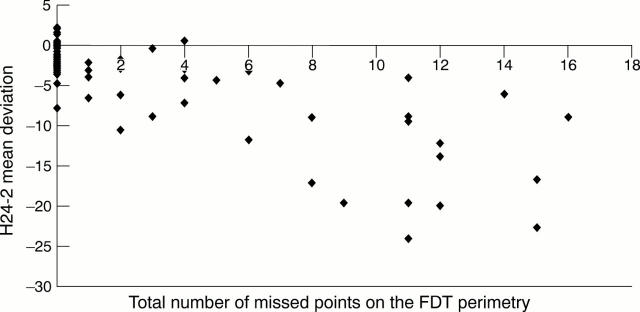Abstract
AIM—To determine the number of missed points on frequency doubling technology (FDT) perimetry that optimise the sensitivity and specificity of the test and to determine the topographical accuracy of the test in a clinical setting. METHODS—In a prospective study, the perimetric data from 99 patients who underwent both FDT perimetry in the screening mode and Humphrey 24-2 (H24-2) were used to determine the sensitivity and specificity of the FDT perimetry compared with the full threshold H24-2 as the gold standard. RESULTS—Missed points on the FDT perimetry correlated with both the mean deviation and the corrected pattern standard deviation on the Humphrey perimetry. A score assigned to abnormal points on the FDT perimetry and the Humphrey total deviation plot showed a significant correlation for both the location and the depth of the defect. In comparing the Humphrey hemifield test with the FDT perimetry results, if at least one missed point on the frequency doubling test was considered as abnormal then the overall sensitivity of the test was 78.1% and the specificity was 89.1%. CONCLUSION—FDT perimetry in the screening mode performed in a clinical setting was highly specific, exhibited reasonable sensitivity, and accurately determined the location and depth of scotomas when compared with the full threshold Humphrey 24-2.
Full Text
The Full Text of this article is available as a PDF (90.5 KB).
Figure 1 .
Scatter plot of Humphrey mean deviation compared with the total number of missed points on the frequency doubling technology test. The correlation is highly significant, r=0.79, p<0.001.
Selected References
These references are in PubMed. This may not be the complete list of references from this article.
- Brusini P., Busatto P. Frequency doubling perimetry in glaucoma early diagnosis. Acta Ophthalmol Scand Suppl. 1998;(227):23–24. doi: 10.1111/j.1600-0420.1998.tb00869.x. [DOI] [PubMed] [Google Scholar]
- Burnstein Y., Ellish N. J., Magbalon M., Higginbotham E. J. Comparison of frequency doubling perimetry with humphrey visual field analysis in a glaucoma practice. Am J Ophthalmol. 2000 Mar;129(3):328–333. doi: 10.1016/s0002-9394(99)00364-5. [DOI] [PubMed] [Google Scholar]
- Cello K. E., Nelson-Quigg J. M., Johnson C. A. Frequency doubling technology perimetry for detection of glaucomatous visual field loss. Am J Ophthalmol. 2000 Mar;129(3):314–322. doi: 10.1016/s0002-9394(99)00414-6. [DOI] [PubMed] [Google Scholar]
- Chauhan B. C., Johnson C. A. Test-retest variability of frequency-doubling perimetry and conventional perimetry in glaucoma patients and normal subjects. Invest Ophthalmol Vis Sci. 1999 Mar;40(3):648–656. [PubMed] [Google Scholar]
- Johnson C. A., Cioffi G. A., Van Buskirk E. M. Frequency doubling technology perimetry using a 24--2 stimulus presentation pattern. Optom Vis Sci. 1999 Aug;76(8):571–581. doi: 10.1097/00006324-199908000-00026. [DOI] [PubMed] [Google Scholar]
- Johnson C. A., Samuels S. J. Screening for glaucomatous visual field loss with frequency-doubling perimetry. Invest Ophthalmol Vis Sci. 1997 Feb;38(2):413–425. [PubMed] [Google Scholar]
- Maddess T., Severt W. L. Testing for glaucoma with the frequency-doubling illusion in the whole, macular and eccentric visual fields. Aust N Z J Ophthalmol. 1999 Jun-Aug;27(3-4):194–196. doi: 10.1046/j.1440-1606.1999.00195.x. [DOI] [PubMed] [Google Scholar]
- Patel S. C., Friedman D. S., Varadkar P., Robin A. L. Algorithm for interpreting the results of frequency doubling perimetry. Am J Ophthalmol. 2000 Mar;129(3):323–327. doi: 10.1016/s0002-9394(99)00399-2. [DOI] [PubMed] [Google Scholar]
- Quigley H. A., Dunkelberger G. R., Green W. R. Chronic human glaucoma causing selectively greater loss of large optic nerve fibers. Ophthalmology. 1988 Mar;95(3):357–363. doi: 10.1016/s0161-6420(88)33176-3. [DOI] [PubMed] [Google Scholar]
- Quigley H. A. Identification of glaucoma-related visual field abnormality with the screening protocol of frequency doubling technology. Am J Ophthalmol. 1998 Jun;125(6):819–829. doi: 10.1016/s0002-9394(98)00046-4. [DOI] [PubMed] [Google Scholar]
- Sponsel W. E., Arango S., Trigo Y., Mensah J. Clinical classification of glaucomatous visual field loss by frequency doubling perimetry. Am J Ophthalmol. 1998 Jun;125(6):830–836. doi: 10.1016/s0002-9394(98)00047-6. [DOI] [PubMed] [Google Scholar]
- Vickers J. C., Schumer R. A., Podos S. M., Wang R. F., Riederer B. M., Morrison J. H. Differential vulnerability of neurochemically identified subpopulations of retinal neurons in a monkey model of glaucoma. Brain Res. 1995 May 22;680(1-2):23–35. doi: 10.1016/0006-8993(95)00211-8. [DOI] [PubMed] [Google Scholar]
- Yamada N., Chen P. P., Mills R. P., Leen M. M., Lieberman M. F., Stamper R. L., Stanford D. C. Screening for glaucoma with frequency-doubling technology and Damato campimetry. Arch Ophthalmol. 1999 Nov;117(11):1479–1484. doi: 10.1001/archopht.117.11.1479. [DOI] [PubMed] [Google Scholar]



